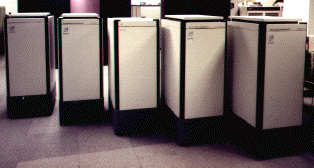 Return to the PREVIOUS PAGE
Return to the PREVIOUS PAGE
Objective: To develop and demonstrate functionality of a cluster of MasPar systems in a hybrid SIMD/MIMD programming model capable of achieving > 5 GFLOPS sustained performance.
Approach: Procure and configure a 4-node MasPar cluster, connected via a 4x4 HiPPI switch. Continue cluster software development work that was begun in October, 1993 and demonstrated on four 16K MP-2's at Supercomputing '93. This effort entails modifying existing MasPar applications codes to take advantage of the additional three MasPars, using PVM over HiPPI. Demonstration of such a configuration will enable scalability of the MasPar architecture and will expand the range of applications to which the MasPar is suited.
Accomplishments: Procured and assembled a 4-node MasPar cluster containing one 16K processor MP-2, one 8K processor MP-1 and two 4K processor MP-1's, all connected via a 4x4 HiPPI switch. Also doubled the capacity of the parallel disk array to 22 Gbytes. Tested functionality of cluster, which has a peak performance of 7.5 GFLOPS.
Significance: The MasPar cluster, the only cluster of its kind, is a unique demonstration of combining SIMD and MIMD styles of programming. It enables MasPar to remove their current system scalability ceiling of 16,384 processors, thus entering them as a competitor in the goal for a teraFLOPS-scalable testbed.
Status/Plans: In FY95, ESS will proceed with the software development work for the cluster. The ESS Parallel Benchmark Working Set codes will be ported to the cluster. The cluster will be made available to subset of user community to allow them to experiment with modifying their codes to use the cluster. ESS will work with MasPar software engineers to mature the operating system to incorporate cluster extensions, with the ultimate goal of making the cluster configuration transparent to the user.
Point of Contact:
 Return to the PREVIOUS PAGE
Return to the PREVIOUS PAGE